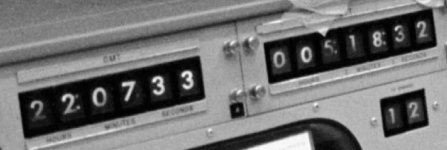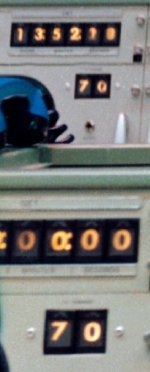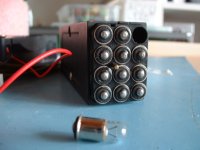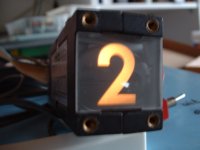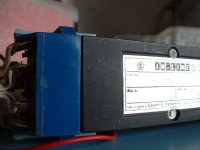Member
Joined 2009
Paid Member
I've seen reference to this display working by the use of rotating cylinders, looks backlit when in operation and not backlit when idle (but numbers still visible). It's not a mechanical counter, it's electronically controlled. Clearly not a Nixie tube either. I'm interested to find out more about it. It's from the 1960's. Anybody have a link to further information ??
Attachments
Here's a lesser known numerical display technology which may fit the bill:
A numeric display which used tiny bulbs (1N4001 diode sized) and had black and clear plastic cutouts for each digit, so that the digits appeared as if they had been produced on a typewriter, i.e., perfectly formed.
I read it here: https://www.eevblog.com/forum/chat/...lisle-st-tottenham-ct-rd-in-their-prime-(uk)/
You mention rotating cylinders, so presumably the bulbs would remain fixed and the plastic cutouts would rotate.
A numeric display which used tiny bulbs (1N4001 diode sized) and had black and clear plastic cutouts for each digit, so that the digits appeared as if they had been produced on a typewriter, i.e., perfectly formed.
I read it here: https://www.eevblog.com/forum/chat/...lisle-st-tottenham-ct-rd-in-their-prime-(uk)/
You mention rotating cylinders, so presumably the bulbs would remain fixed and the plastic cutouts would rotate.
Early "digital" alarm clocks had a similar arrangement.
Later ones had small flipping cards, but no light, like a rolodex.
Later ones had small flipping cards, but no light, like a rolodex.
Member
Joined 2009
Paid Member
I used to have some of those old plastic and bulb displays - kick myself for no longer having them. They worked like a Nixie in that there were no moving parts and each character was at a different depth from the front of the display. No, the images I posted are not of this type. The digits are always at the same depth regardless of whether it's a '1' or a '9'.
It's not a flip chart type either because there are no horizontal lines across the numbers.
I saw a video of one working, just can't find it right now but will post it later if/when I do. The numbers changed very rapidly and the video was from the 60's so the mechanism was not obvious but a quickly rotating cylinder would work.
We're not there yet!
It's not a flip chart type either because there are no horizontal lines across the numbers.
I saw a video of one working, just can't find it right now but will post it later if/when I do. The numbers changed very rapidly and the video was from the 60's so the mechanism was not obvious but a quickly rotating cylinder would work.
We're not there yet!
A type of display used ten tiny slide-like projectors behind a frosted glass screen. It was clever: the lenses corrected the geometrical aberrations caused by the juxtaposition of each projector, and the result was very satisfactory visually: good contrast, luminosity, nice font types, etc.
It was rather bulky though, and used ten incandescent light bulbs as sources
It was rather bulky though, and used ten incandescent light bulbs as sources
Member
Joined 2009
Paid Member
Wow, sounds complicated. But that can't be this item either, too bulky. Amazing though what people came up with before we had invented the LED.
I had one of those for years, the numbers were on rotating barrels, flattened at each side where the numbers were. The numbers were not lit from behind, just from the front with a little neon tube. I suppose that could be done back lit, but the displays shown in the original post seem too tight for that.Early "digital" alarm clocks had a similar arrangement.
We did have a Zenith TV in the 60s in which the channel number was projected into the center of the channel knob. I loved it. Have owned some Maganvox that also used projected numbers. Rather bulky devices, thought.
The advent of digital computers at the time made consumer companies race to appear to be "up to date"
and have digital displays in their products, even if the underlying mechanism was still analog.
Even the "ticking" second hand on analog clocks, which I have always found to be really annoying.
and have digital displays in their products, even if the underlying mechanism was still analog.
Even the "ticking" second hand on analog clocks, which I have always found to be really annoying.
Member
Joined 2009
Paid Member
Maybe I was too hasty, as these links shows small displays as you describeWow, sounds complicated. But that can't be this item either, too bulky. Amazing though what people came up with before we had invented the LED.
http://www.industrialalchemy.org/articleview.php?item=511
Member
Joined 2009
Paid Member
what I’m looking to identify seems not to be rotating cylinders.
Yes, I think the description I found was of a projection display as described in your link, and which had nothing to do with rotation.
There was a sort of alphanumeric CRT display from Telefunken. They had some patent issues with an US manufacturer and discontinued them. Can't remember under what name it was available.
Some of these displays used stacked perspex squares with the numbers milled in the surface. Each square had a lamp shining on its bottom or top edge, and when lit, the milled number would be vissible.The images you posted show digits at different depths as I see it...!
Because of the stack (10 deep) the numbers when changing seemed to move forward or backward.
Jan
These are the ones I described in#5I still have four, maybe ever make a clock....
View attachment 1190142View attachment 1190143View attachment 1190144
- Home
- Design & Build
- Parts
- What is this analogue numerical display?
